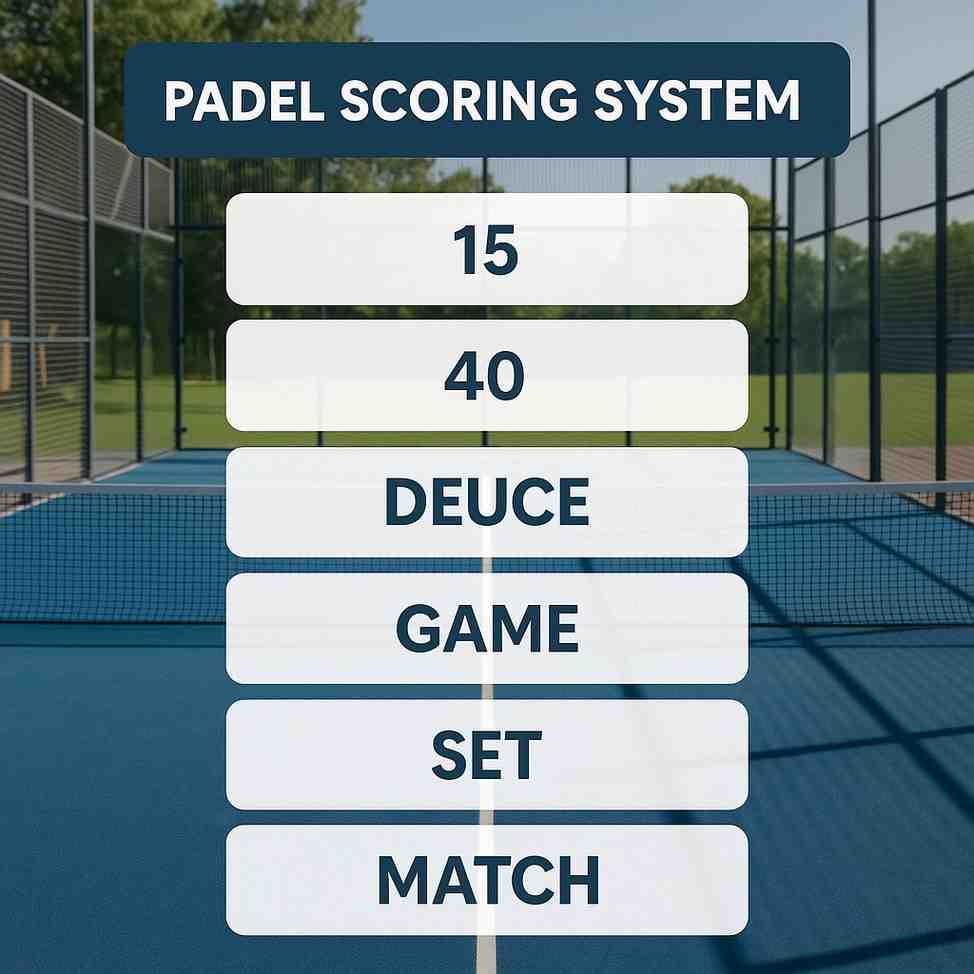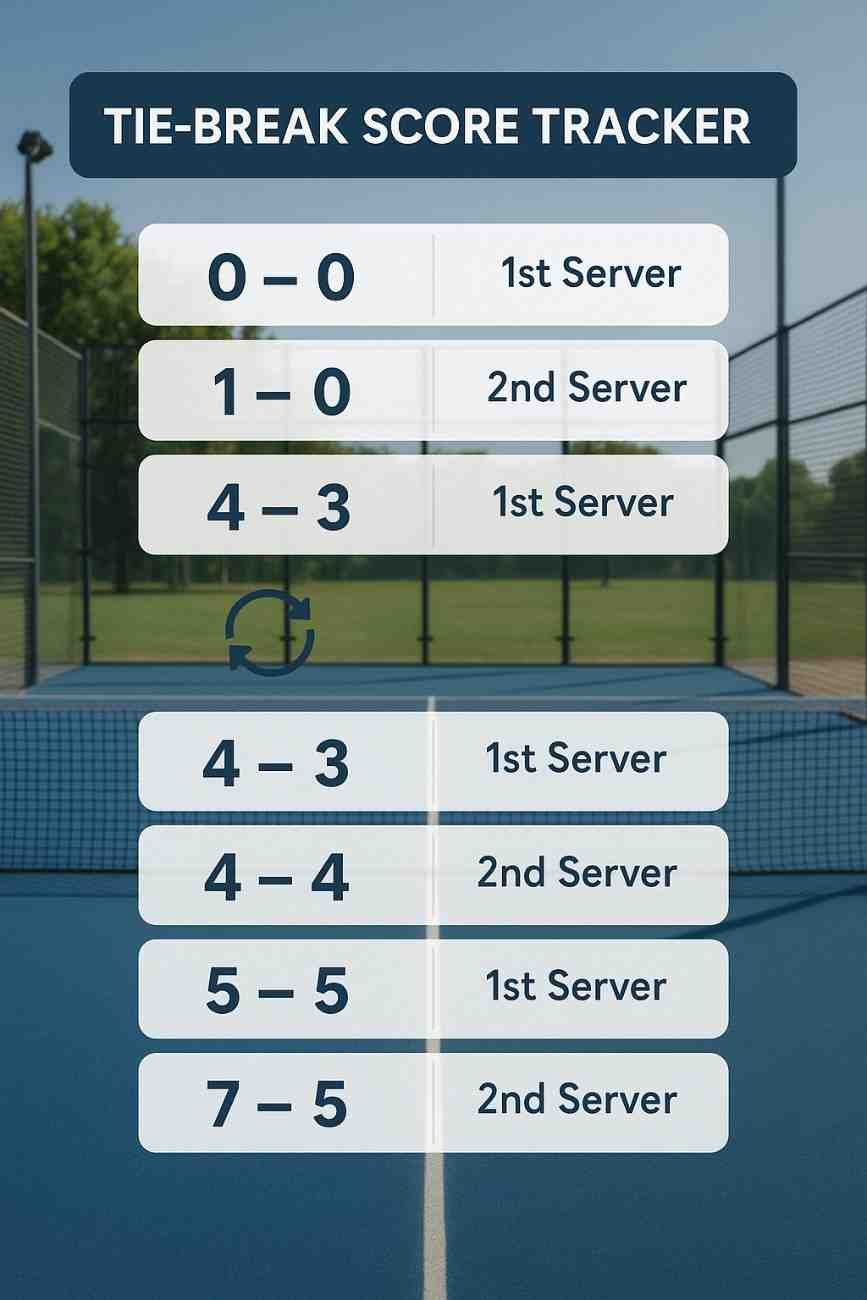Want a shortcut? Take a quiz and find your perfect Padel Racket in 30 secs.

The Ultimate Padel Scoring System Explained: How It Works (2025 Guide)
Padel is quickly becoming one of the most popular racket sports around the world — and if you’re new to the game, one of the first things you’ll need to learn is the Padel scoring system. While it shares similarities with tennis, padel has a few specific rules that make scoring unique and essential to understanding for smooth gameplay.
Grasping the Padel scoring system is essential for anyone looking to enjoy the sport and improve their game. Whether you’re playing a friendly match or entering a local tournament, knowing how points, sets, and tie-breaks work helps you stay on track, follow the game flow accurately, and compete with more confidence.
In this guide, we’ll break down the entire Padel scoring system — from point progression and set formats to tie-break rules and common mistakes. This will give you the confidence to step on the court knowing exactly how each match unfolds.
Essential Structure of the Padel Scoring System
The padel scoring system is almost identical to tennis, which makes it easier to learn if you’re familiar with racket sports.
Each Game follows this sequence:
15 – 30 – 40 – Game
Here’s how Padel’s game points are counted:
- No points = Love
- First point = 15
- Second point = 30
- Third point = 40
- Fourth point = Game (if there’s a 2-point lead)
To win a game, a team must score at least four points and lead by two points.
But if both teams reach 40–40, the score is called a deuce. From there:
- The next point gives an advantage to the winning team
- If they win again, they win the game.
- If they lose the next point, the score returns to deuce
This process continues until one team gains two consecutive points after deuce.
These are the core padel scoring rules every player needs to remember, especially in close games.
Ready for More?
- Best Nox Padel Rackets
- Nox vs Wilson: Which Padel Racket Brand is Better?
- Best Padel Rackets for Spin and Control
- Why Do Padel Rackets Have Holes
- Head vs Nox: Which Padel Racket Brand is Best for You?
- Why Do Some Padel Rackets Cause Elbow Pain
- Best Junior Padel Rackets for Young Players
- Best carbon fiber padel rackets
- Best Padel Rackets for 2025
Padel Scoring System: How Sets and Matches Work
Understanding padel match rules is essential, whether you’re playing for fun or in a tournament.
How many games make a set?
A standard padel set consists of 6 games. To win the set, a team must win at least six games and lead by a margin of two games or more.
For example, a score of 6–4 indicates that the set has been won. If the score reaches 6–6, a tiebreak is played.
Want to keep score like a pro? Check out this top-rated Padel Score Tracker on Amazon.
How many sets are in a padel match?
Most Padel matches follow the best-of-three-sets rule.
This means the first team to win two sets wins the match.
Casual vs Competitive Format
In casual matches, players often agree on flexible formats. Some may play one long set or use faster scoring rules.
In official tournaments, matches always follow strict padel match rules:
- Best of 3 complete sets
- Tie-breaks at 6–6
- Change of sides every odd-numbered game
Knowing these rules helps you adapt your strategy and pace, whether you’re playing socially or competing seriously.
What Happens in a Tiebreak?
A tiebreak in padel is used when both teams are evenly matched in a set.
When is a tiebreak triggered?
A tiebreak is triggered when the game score in a set reaches 6–6. Instead of continuing regular games, players play a tiebreaker to decide the winner of the set.
Tie-break scoring in Padel
The tie-break uses a point-by-point system, different from regular game scoring.
- The first team to reach 7 points wins
- But they must lead by at least 2 points (e.g., 7–5, 8–6, 10–8)
Teams switch sides every 6 points to balance the court conditions.
Who serves in a tiebreak?
- The first serve is by the next player in the serving order.
- That player serves one point, then the serve rotates every two points
- Players continue alternating serve and side after every six total points
This format makes tie-breaks fast paced and exciting, mainly when the score stays close.

Who Keeps Score in a Padel Match?
Understanding how to keep score in padel is just as important as learning the padel scoring system itself. Whether you’re playing casually or in a professional match, someone must accurately track the points.
Casual Matches: Players Handle Scoring
In most friendly or recreational games, players track their scores. The player serving is responsible for announcing the score before every point, starting with their own team’s score first.
For example, if the server’s team has won three points and the other team two, the call should be 40–30.
This method is simple and keeps the padel scoring system flowing naturally without any confusion.
Tournaments: Referees or Scoreboards
In official matches and tournaments, a referee or umpire keeps score. They follow every point closely and call out scores, rule violations, and decisions as they occur.
Some modern courts utilize electronic scoring systems to display scores in real time, ensuring fairness and accuracy.
Whether you’re playing with friends or in a ranked match, knowing how to keep score in Padel helps you follow the game confidently and avoid disputes. It’s a core part of mastering the Padel scoring system.
Common Scoring Mistakes to Avoid
Even experienced players can make simple errors if they don’t fully understand the Padel scoring system. These mistakes can interrupt gameplay and lead to unnecessary confusion, especially during close matches.
Here are the most common scoring slip-ups to watch out for:
1. Forgetting to Change Sides
In the padel scoring system, players must switch sides after every odd-numbered game (e.g., after the 1st, 3rd, and 5th games). Forgetting this is a common mistake in casual matches and can create an unfair court advantage.
2. Misunderstanding Deuce and Advantage
When the score reaches 40–40, it’s called a deuce. From there:
- The next point gives a team advantage
- If they win again, they take the game
- If they lose it, it returns to deuce
Misjudging this sequence can cause disputes. Learning how it works is key to using the Padel scoring system correctly.
3. Serving from the Wrong Side After Deuce
After a deuce, many players serve from the wrong side of the court. Remember:
- At deuce, serve from the right side
- After gaining an advantage, serve from the left side.
By understanding these details of the Padel scoring system, you’ll avoid mistakes, play smoother matches, and improve your overall game awareness.
Bonus: Padel Tie-Break & Golden Point (New Rules)
The padel scoring system has undergone significant evolution in recent years, particularly in professional tournaments. One major update is the introduction of the Golden Point rule, designed to speed up matches and add excitement at crucial moments.
What Is the Golden Point Rule?
In traditional scoring, when the score reaches 40–40 (deuce), players must win two consecutive points to win the game.
With the Golden Point system, this changes:
- When the score is deuce, the following point decides the game
- There is no advantage
- The receiving team chooses which player will return the serve
- This format adds pressure and intensity to every deuce situation.
When and Where Does It Apply?
The Golden Point rule is used in all World Padel Tour (WPT) matches and several international competitions. Some clubs also apply this rule during amateur events to make matches faster and more engaging.
Understanding how the Golden Point fits into the padel scoring system helps players adapt their tactics — especially during close games.
Conclusion
Now that you understand the complete Padel scoring system, keeping track of points, games, sets, and tie-breaks is a lot simpler.
From basic game scoring to advanced rules like Golden Point, learning how the padel scoring system works helps you play with more confidence, whether it’s a friendly match or a competitive tournament.
The next time you step on the court, focus not just on your shots but also on staying sharp with the score. It’s a key part of improving your game and avoiding unnecessary mistakes.
Ready for More? You’ll Love This Insight
- How to Choose the Right Padel Racket
- Best Babolat Padel Rackets
- Head vs Babolat: Which Padel Racket Brand is Better?
- Best Padel Rackets for Women
- Best Padel Rackets for Men
- Nox vs Adidas – Which Padel Racket Brand is Right for You in 2025?
- The Difference Between Fibreglass and Carbon Padel Rackets
- How to Replace the Grip on a Padel Racket
- Can You Use a Tennis Racket for Padel?
- Head vs Wilson: Which Padel Racket Brand is Better in 2025?
- Best Padel Racket Accessories
- Head vs Adidas: Which Padel Racket Brand is Best for You?
- Adidas vs Wilson: Which Padel Racket Brand is Better?
- The Evolution of Padel Rackets Over the Years
- Nox vs Babolat: Which Padel Racket Brand is Better in 2025?
- Best Padel Rackets for Professional Players
FAQs—Padel Scoring System
Most padel matches are played as the best of 3 sets. This means the first team to win two sets wins the game, following the standard padel scoring system.
In the traditional padel scoring system, a deuce occurs when both teams reach 40 points, requiring a team to win two consecutive points to win the game.
The golden point rule speeds this up—at deuce, the very next point decides the game, with no advantage scoring.
When the game score in a set reaches 6–6, a tiebreak is played to decide the winner of that set. The tiebreak is played to 7 points, with a required two-point lead, as part of the official padel scoring system.
The player who is next in the regular serving rotation starts the tiebreak. Serves then alternates every two points throughout the tie-break game.






